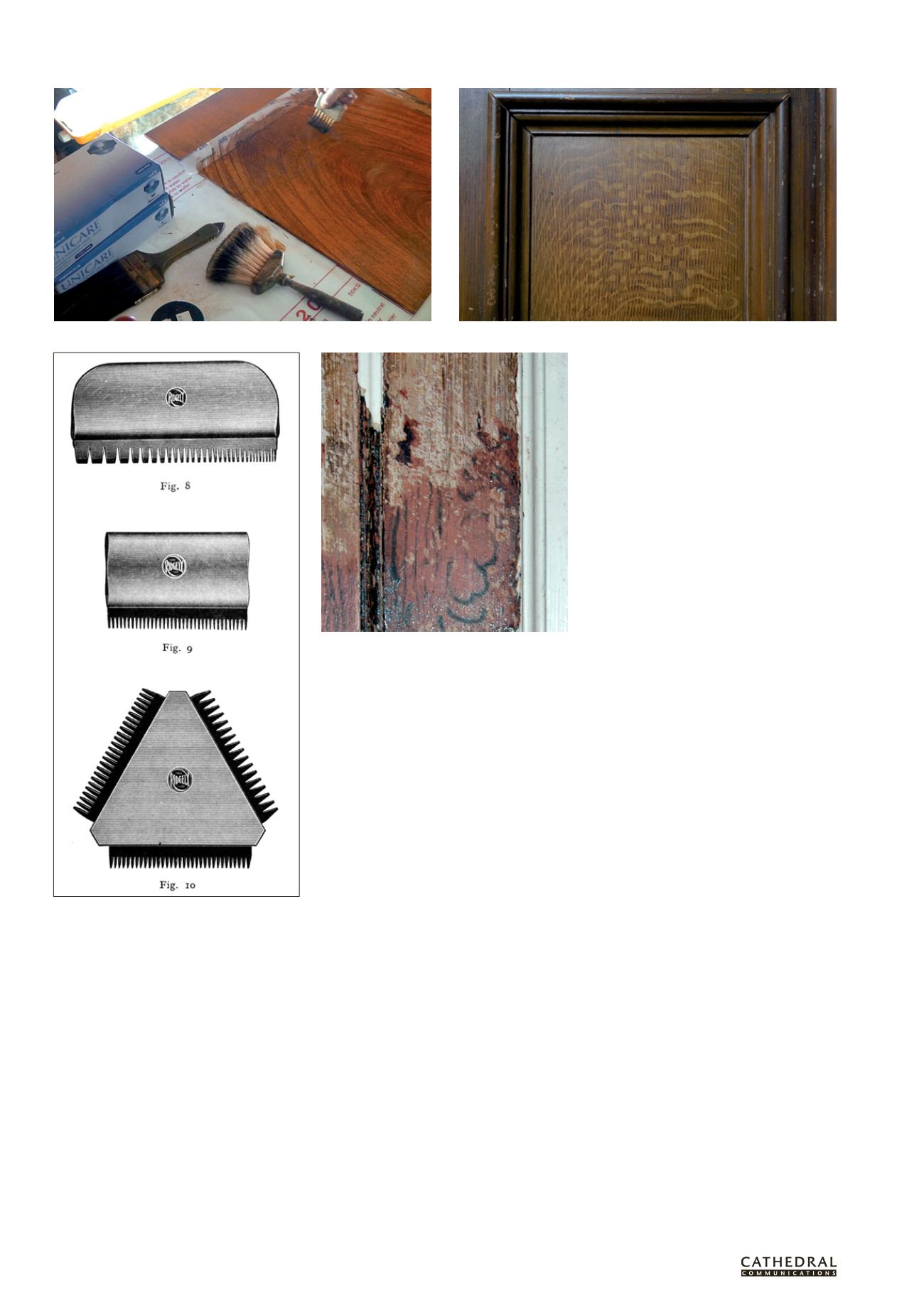
1 6 2
T H E B U I L D I N G C O N S E R VAT I O N D I R E C T O R Y 2 0 1 4
T W E N T Y F I R S T E D I T I O N
INTERIORS
5
graining was used continually as a decorative
technique over the 200 years under
consideration, although its popularity grew
and waned according to the architectural
taste of the day. Generally speaking it was
considered fashionable during the Baroque
period at the end of the 17th and beginning of
the 18th centuries, but fell into decline during
the Palladian and neo-classical periods of
architecture. It found favour once again in
the Regency period in the opening decades
of the 19th century and remained a strong
decorative force until the reforming influence
of individuals such as John Ruskin and AWN
Pugin in the middle of the century declared
such imitative work a sham. Regardless,
boards and dado rails. The property had been
built to the designs of Charles Steuart in 1785,
but it underwent extensive redecoration for
the second Lord Berwick 17 years later, in
1812-13. Lord Berwick had recently married
and was spending large sums of money
to bring his property in line with current
London Regency architectural tastes. This
was reflected in the lavish style of decoration
he employed in the Octagon Room, which
was adapted for use as a study. The extent of
the alterations also contributed to Berwick’s
downfall, as his expenditure at Attingham
far exceeded his fortune and he was made
bankrupt in 1827.
Initial analysis indicated the presence of
a complex manipulated scheme consisting of
multiple opaque and translucent red layers as
well as varnish coatings applied over a black
ground. There was some evidence to suggest
that hard particles of grit had been added to
this base coat to lend it variety and texture.
The scheme was probably intended as an
imitation of rosewood. The analysis, coupled
with uncovering trials, allowed for the
scheme to be successfully reproduced by the
National Trust, lending the room back some
of its original Regency opulence.
Despite the popularity of graining at
this time, the technique was by no means
ubiquitous, and the absence of graining in
a building can indicate a specific aesthetic
choice and approach to interior decoration.
This eschewing of imitative painting
techniques was evident in the early 18th-
century Quaker meeting houses in both
Ringwood, Hampshire and Bristol. In
its place plain solid colours were used to
decorate the interior woodwork.
Another omission of particular interest
can be found in the much later example of
William Morris’s Red House in Bexleyheath,
London, which was designed by Philip Webb
in 1859–60. A riot of colour, patterned
decoration, wall paintings and textiles were
identified as forming part of the property’s
initial interior design. However, not one
example of original graining was pinpointed.
In many ways Red House was the testing
ground where Morris experimented with
design ideas that were to later find form in his
commercial work in the closing decades of
the 19th century. His avoidance of imitative
techniques such as graining was, for Morris
and his cohorts, a statement of intent.
Graining tools (Photo: Hare & Humphreys Ltd)
Victorian oak graining showing the use of ‘lights’ running across the grain
Oak graining uncovered during the investigation of the
dairy complex at Kenwood House, Hampstead: the
dairy was built in 1795 as a picturesque eye catcher
on the brow of the hill to the west of the main house,
hence the high quality of its finishes (Photo: Jane
Davies Conservation, by courtesy of English Heritage)
Early 20th century ‘Ridgely’ graining combs
illustrated in
The Modern Painter and Decorator
(see
Recommended Reading
)
graining continued to be used in many
buildings, but it does not appear to have
recovered critical acceptance until the last
quarter of the century.
It is interesting to note that the
popularity of some woods over others also
changed during the period.
HOW GRAINING WAS USED
At a time when softwood was almost always
painted, the principal aim of graining was
not only to provide pattern and richness to
an interior, but to give an impression that a
more expensive timber had been employed.
The most commonly imitated wood was oak,
no doubt because of the long tradition of
its use in Britain and the familiarity of its
figuring. Other popular hardwoods included
walnut and mahogany, which could convey
an even greater degree of luxury.
As the decorator’s manuals of the day
suggest, the techniques involved in the
execution of graining could be relatively
simple or they could involve the intricate
application of many strata.
One such elaborate graining decoration
was identified on all the joinery in the
Octagon Room at Attingham Park,
Shropshire, including the entrance door
and its architrave, the window cases and
architraves, built-in bookcases, skirting


